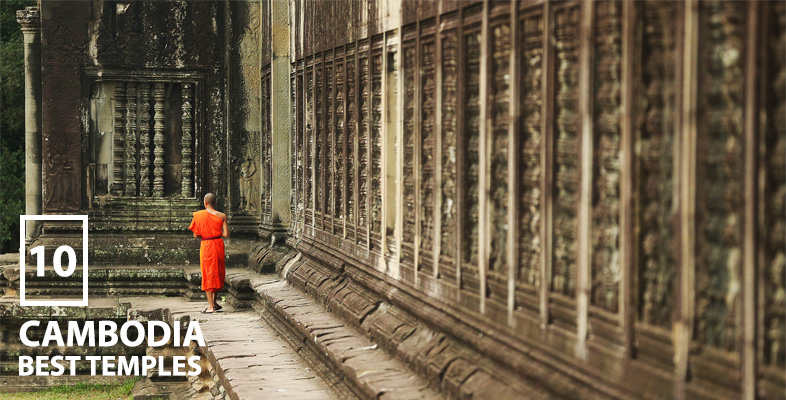
- On 14 August, 2020
- In ALL BLOGS CAMBODIA BLOGS
- Tags Tags: Angkor Wat Temple, Banteay Chhmar Temple, Banteay Srei Temple, Bayon Temple, Beng Mealea Temple, cambodia, Cambodia Temples, Koh Ker Temples, Pre Rup Temple, Sambo Prey Kuk Temple, Ta Prohm Temple, Ta Som Temple
CAMBODIA’S 10 MUST-SEE TEMPLES
One thing Cambodia is famous for is its beautiful ancient temples spread around the country, which have miraculously survived to the present day despite war and decay. More recently, these temples have been drawing backpackers in for the exploration of a lifetime! The temples in Cambodia have tales to narrate, but most importantly they stand as architectural gems. The rock cut art and carvings in these landmarks have their own old world charm, something that will urge you to capture for lifetime.
This blog features a list of stunning Cambodia temples, which you must visit during your trip to the country. As you read, you will also get to know important details regarding each of it while exploring the Cambodia temples history. So, let’s begin!
Koh Ker Temples
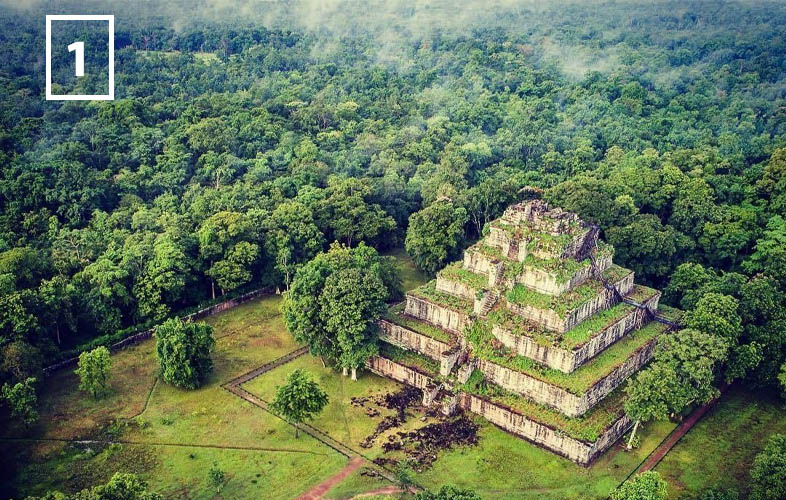
Compared to earlier examples, many sandstone towers in and around Prasat Thom are of enormous size and, besides Phnom Bok in Angkor, sheltered the largest Lingas known in Cambodia. The French archaeologist Lunet die Lajonquière came to the conclusion, that, given the limitations of Khmer constuction techniques, the use of wooden carpentry had to be extended in Koh Ker.
A characteristic of both architecture and the sculpture of Koh Ker is the use of huge blocks of stone. Sandstone was abundantly available in this area and, compared to Angkor, there was less of a problem in moving it. Nevertheless, brick still predominant as material, but the use natural stone, sandstone and also laterite, was increasing.
Square ground plans were the most common, but rectangular buildings occur more often than in previous periods, from now on not only for galleries, but for libraries and other kinds of edifices, too. In particular, the evolution of galleries, only hinted at in earlier periods, makes some advance at Koh Ker’s principal temple Prasat Thom, both in the almost continuous series of gallery buildings of its second enclosure and in the uninterrupted semi-open column hall of Prasat Thom’s exterior gate. The arrangement of towers in quincunx, which began at the Bakheng and became a favourite pattern for some time was less predominent in Koh Ker, however, it occurs at Prasat Krachap.
All the monuments in Koh Ker are dedicated to Hindu deities, mainly Shiva. Remarkably, there are no shrines for the Buddha. This is in contrast to earlier and later periods of Khmer history, when the Buddha, besides Shiva and Vishnu, used to be venerated as one of the three most important supernatural beings “imported” from India – despite the fact that in this country of origin the Buddha was regarded as unorthodox or even heretical by devotees of Shiva and Vishnu.
Angkor Wat Temple
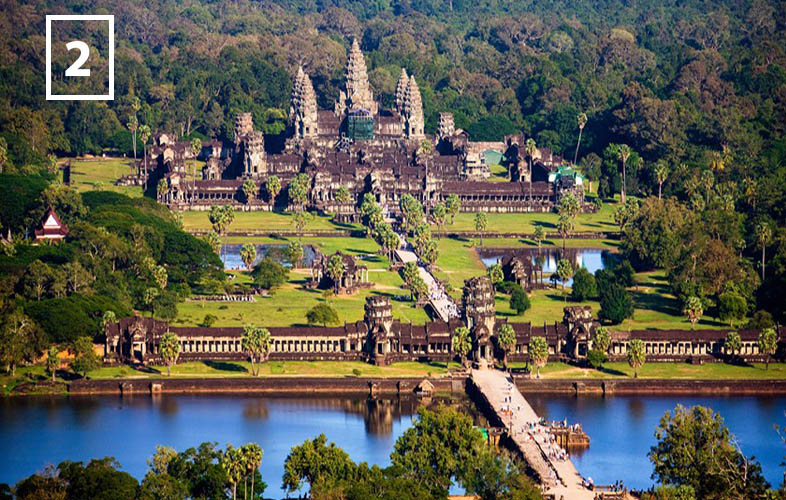
Angkor Wat is a temple complex at Angkor, Cambodia, built for the king Suryavarman II in the early 12th century as his state temple and capital city. As the best-preserved temple at the site, it is the only one to have remained a significant religious centre since its foundation – first Hindu, dedicated to the god Vishnu, then Buddhist. It is the world’s largest religious building. The temple is at the top of the high classical style of Khmer architecture. It has become a symbol of Cambodia, appearing on its national flag, and it is the country’s prime attraction for visitors.
Angkor Wat Temple combines two basic plans of Khmer temple architecture: the temple mountain and the later galleried temple, based on early Indian Hindu architecture, with key features such as the Jagati. It is designed to represent Mount Meru, home of the devas in Hindu mythology: within a moat and an outer wall 3.6 kilometres (2.2 mi) long are three rectangular galleries, each raised above the next. At the centre of the temple stands a quincunx of towers. Unlike most Angkorian temples, Angkor Wat is oriented to the west; scholars are divided as to the significance of this.
The temple is admired for the grandeur and harmony of the architecture, its extensive bas-reliefs and for the numerous devatas (guardian spirits) adorning its walls. The modern name, Angkor Wat, means “City Temple”; Angkor is a vernacular form of the word nokor which comes from the Sanskrit word nagara meaning capital or city. Wat is the Khmer word for temple. Prior to this time the temple was known as Preah Pisnulok, after the posthumous title of its founder, Suryavarman II.
Bayon Temple
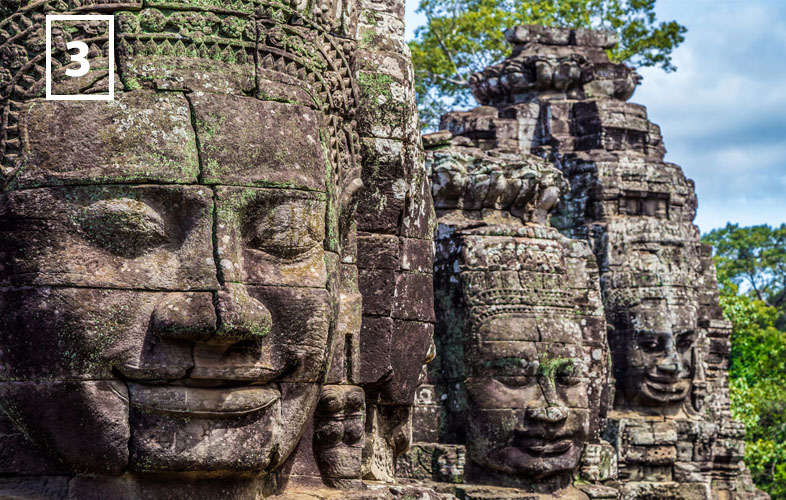
At the heart of Angkor Thom is the 12th-century Bayon, the mesmerising, if slightly mind-bending, state temple of Jayavarman VII. It epitomises the creative genius and inflated ego of Cambodia’s most celebrated king. Its 54 Gothic towers are decorated with 216 gargantuan smiling faces of Avalokiteshvara, and it is adorned with 1.2km of extraordinary bas-reliefs incorporating more than 11,000 figures.
There are some 50 towers around the ruined temple, with over 200 faces showing varying degrees of erosion and wear. Each face is 4 metres high and is facing one of the cardinal directions of the compass. They all have the same serene smile, with eyes closed, representing the all-knowing state of inner peace, and perhaps even a state of Nirvana. There are also many complicated and exquisite bas-reliefs around the temple, with scenes depicting land and naval warfare, market scenes and even the construction of the temple itself.
The best time for photographs is when the sun is rather low, near sunrise and sunset, as this brings out the detail in the bas-reliefs.
Ta Prohm Temple
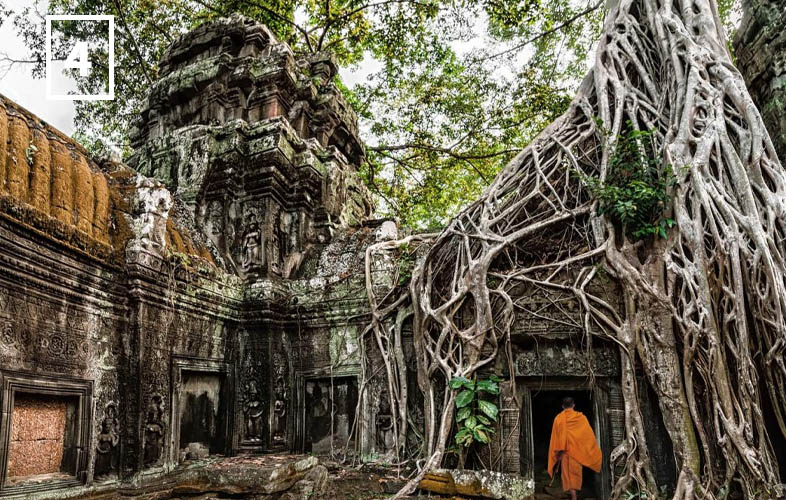
Ta Prohm is the undisputed capital of the kingdom of the Trees’. It has been left untouched by archaeologists except for the clearing of a path for visitors and structural strengthening to stave of further deterioration.
Because of its natural state, it is possible to experience at this temple the wonder of the early explorers when they came upon these monuments in the middle of the nineteenth century.
Shrouded in dense jungle the temple of Ta Prohm is ethereal in aspect and conjures up a romantic aura. Fig, banyan and kapok trees spread their gigantic roots over stones, probing walls and terraces apart, as their branches and leaves intertwine to form a roof over the structures. Trunks of trees twist amongst stone pillars. The strange, haunted charm of the place entwines itself about you as you go, as inescapably as the roots have wound themselves about the walls and towers’, wrote a visitor 40 years ago.
A Sanskrit inscription on stone, still in place, give details of the temple. Ta Prohm 3,140 villages. It took 79,365 people to maintain the temple including 18 great priests, 2,740 officials, 2,202 assistants and 615 dancers. Among the property belonging to the temple was a set of golden dishes weighing more than 500 kilograms, 35 diamonds, 40,620 pearls, 4,540 precious stones, 876 veils from China, 512 silk beds and 523 parasols. Even considering that these numbers were probably exaggerated to glorify the king, Ta Prohm must have been an important and impressive monument.
Beng Mealea Temple

Beng Mealea was built as a Hindu temple, but some carvings depict Buddhist motifs. Its primary material is sandstone and it is largely unrestored, with trees and thick brush thriving amidst its towers and courtyards and many of its stones lying in great heaps. For years it was difficult to reach, but a road recently built to the temple complex of Koh Ker passes Beng Mealea and more visitors are coming to the site, as it is 77 km from Siem Reap by road.
The history of the temple is unknown and it can be dated only by its architectural style, identical to Angkor Wat, so scholars assumed it was built during the reign of king Suryavarman II in the early 12th century. Smaller in size than Angkor Wat, the king’s main monument, Beng Mealea nonetheless ranks among the Khmer empire’s larger temples: the gallery which forms the outer enclosure of the temple is 181 m by 152 m. It was the center of a town, surrounded by a moat 1025 m by 875 m large and 45 m wide.
Beng Mealea is oriented toward the east, but has entranceways from the other three cardinal directions. The basic layout is three enclosing galleries around a central sanctuary, collapsed at present. The enclosures are tied with “cruciform cloisters”, like Angkor Wat. Structures known as libraries lie to the right and left of the avenue that leads in from the east. There is extensive carving of scenes from Hindu mythology, including the Churning of the Sea of Milk and Vishnu being borne by the bird god Garuda. Causeways have long balustrades formed by bodies of the seven-headed Naga serpent.
It was built mostly of sandstone: Beng Mealea is only 7 km far from the angkorian sandstone quarries of Phnom Kulen, as the crow flies. Presumably sandstone blocks used for Angkor were transported along artificial water canals and passed from here. Despite of lack of information, the quality of architecture and decorations has drawn the attention of French scholars just from its discovery.
Banteay Srei Temple
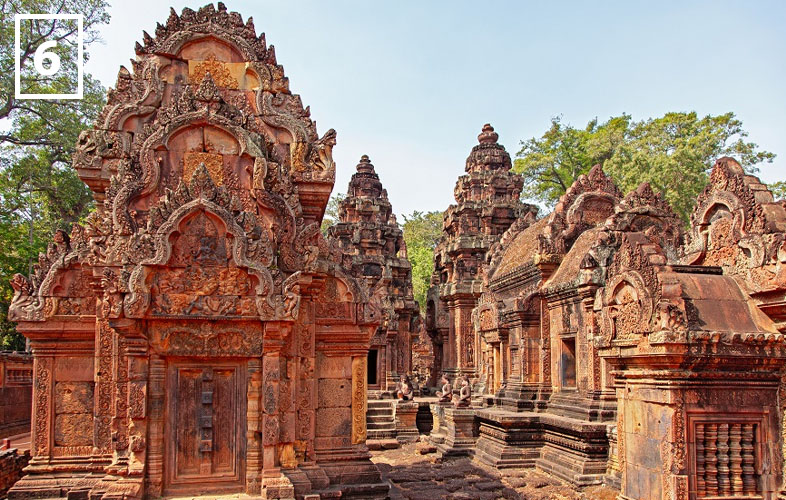
When Banteay Srei was first rediscovered it was thought to date back to the 13th or 14th century due to its refined carvings. However, inscriptions later found at the site place its consecration very precisely on 22nd of April, 967 A.D. It is the only major temple not to be built by a King. The construction is attributed to Yajnavaraha, a courtier and King’s counsellor. The temple was expanded and further built upon in later years and remained in use until at least the 14th century.
The temple was rediscovered in 1914 but the site was not initially cleared. A few years later however, when a French politician and novelist stole some remains from the site, the ensuring attention renewed interest in the area and the restoration process began. The restoration was the first really successful use of anastylosis (the process of using original architectural elements of the building to restore it), a method which was then adopted for the restoration of many other Angkorian monuments.
Banteay Srei is really quite a different experience to many of the other Angkorian temples. Here the demonstration of wealth, power and the veneration of the gods is apparent in detail and intricacy, rather than in the sense of enormity and gravitas of Angkor Wat or Bayon. It provides an interesting counterpoint for those willing to go a little bit further in their journey of understanding and experiencing the Kingdom of Angkor.
Pre Rup Temple
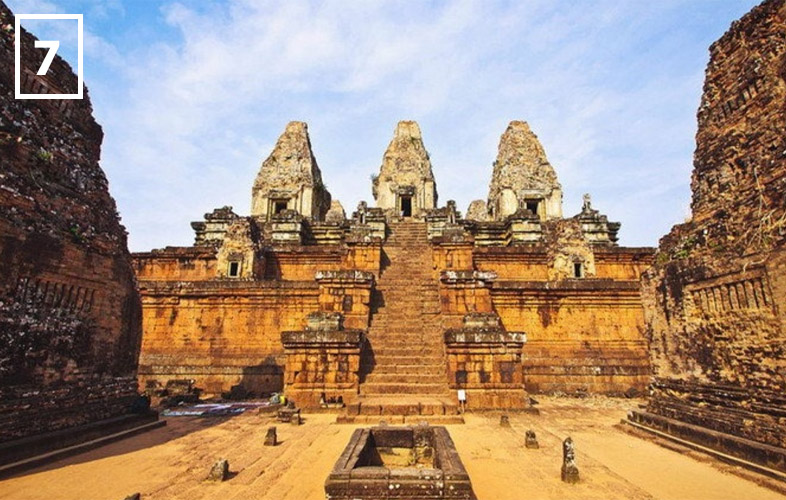
The Pre Rup was the state temple of King Rajendravarman II. It is a mountain temple build in the year 961, located just South of the large East baray and the East Mebon, another mountain temple build by Rajendravarman II just 9 years earlier. In the early 20th century the Pre Rup had been completely overgrown and covered with soil. The temple was excavated during the 1930’s by French conservators George Trouvé and Henri Marchal.
Most striking feature of the Pre Rup temple are the three large towers on either side of the Eastern entrance, the main entrance of the temple. The first tower to the right of the entrance is missing, although the base is there. The tower was either never build or demolished and the stones used elsewhere later. The towers were probably build later during the reign of the next King, King Jayavarman V. The central tower contains a sanctuary room. The lintels contain Indra riding the elephant Airavata, Vishnu on Garuda (a large mythological bird, the mount of Vishnu) and other depictions.
Sambo Prey Kuk Temple
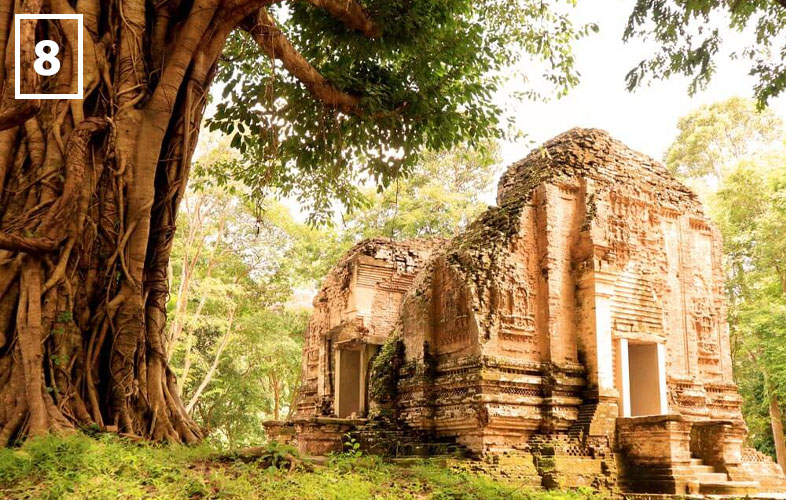
Cambodia’s most impressive group of pre-Angkorian monuments, Sambor Prei Kuk encompasses more than 100 mainly brick temples scattered through the forest, among them some of the oldest structures in the country. The attraction was recently named Cambodia’s third Unesco World Heritage site. Originally called Isanapura, Sambor Prei Kuk served as the capital of Upper Chenla during the reign of the early 7th-century King Isanavarman and continued to serve as an important learning centre during the Angkorian era.
The main temple area consists of three complexes, each enclosed by the remains of two concentric walls. The principal temple group, Prasat Sambor, dating from the 7th and 10th centuries, is closest to the entrance and is dedicated to Gambhireshvara, one of Shiva’s many incarnations (the other groups are dedicated to Shiva himself). Several of Prasat Sambor’s towers retain brick carvings in fairly good condition, and there is a series of large yoni (female fertility symbols) around the central tower.
Prasat Yeai Poeun is arguably the most atmospheric of the three ensembles, as it feels lost in the forest. The eastern gateway is being both held up and torn asunder by an ancient tree, the bricks interwoven with the tree’s extensive, probing roots. A truly massive tree shades the western gate. Prasat Tor is the largest of the Sambor Prei Kuk complexes. It boasts excellent examples of Chenla carvings in the form of two large, elaborately coiffed stone lions.
Banteay Chhmar Temple
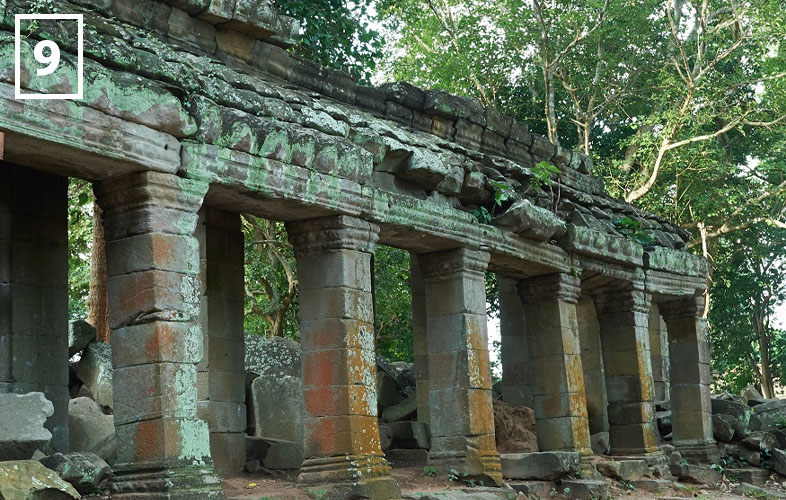
This enormous complex, which was a temple city, is one of the most intriguing in the Khmer empire, both for it’s scale and it’s remote location. Never excavated, Banteay Chhmar fits the picture of a lost Khmer city with its ruined face-towers, carvings, forest surroundings and bird life flying through the temple. It has a romantic and discovery feel to it.
Banteay Chhmar dates from the late 12th to the early 13thcentury and it means Narrow Fortress. It is thought to have been built by Jayarvarman II. It was later rebuilt by Jayarvarman VII as a funerary temple for his sons and four generals who had been killed in a battle repelling a Cham invasion in 1177.
Like Preah Khan, Angkor Wat and Angkor Thom, Banteay Chhmar originally enclosed a city with the temple at the heart. No traces of the city that surrounded the temple remain.
The temple area covers 2km by 2 and a half km. It contains the main temple complex and a number of other religious structures and a baray to its east. A mote filled with water and a huge wall inside of that encloses the center of the temple. This mote is still used to present day by locals for fishing and daily chores. A bustling small market and village bounds the east and south east and perhaps there has been continuous habitation there since the founding of the temple.
Ta Som Temple
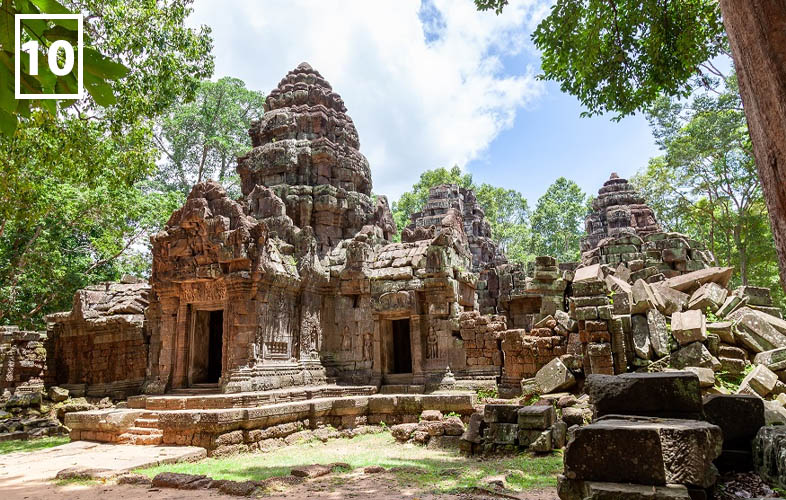
Ta Som is located along the Grand Circuit road after passing Neak Pean and was built in the late 12 century. The interesting thing about Ta Som is that none of it has been restored, with the exception of clear undergrowth vegetation. Also, there is a gate tower at the entrance with four faces of Buddha, very similar to the gates at the entrance/exit to Angkor Thom.
Through this entrance gate there are three walls to pass through. The structures are a bit smaller but still impressive. One of the main attractions at Ta Som is the final gate at the east entrance. From the west it looks like an ordinary gate entrance but walk through the gate and turn around to see the gate completely engulfed by the roots of a tree growing on top. Take the time to walk all the way through the complex because this is the last gate and it is very unassuming from the west. Very impressive to see. There were few people when I was here and it was quite enjoyable.